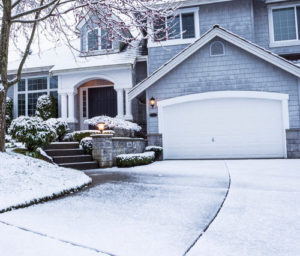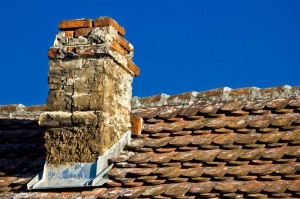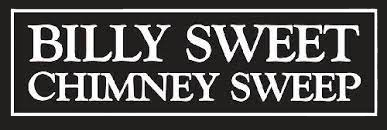by Billy Sweet | Feb 29, 2020 | Chimney Maintenance
There are many issues that can arise during the winter months—things that affect the bills you pay and the safety of your home. The problems that affect your home this winter are not always caused by your fire appliance, your heater, or even neglect. Many problems arise because of weather, storms, damage, or other things entirely out of our control. In order for our customers to have the safest home possible this winter and every winter, we recommend these tips.
Gutters and Drains
Gutters and outside drains are great assets during freezing winters and wet springs. However, if they aren’t properly maintained, they can become a hazard. Leaves and debris left inside gutters and drains can cause a clog, allow your water flow to stall and freeze, and even lead to leaks and water damage outside the gutter system. A gutter problem doesn’t just affect the roof, eaves, and house. An overflowing or damaged gutter can lead to washout and damage to your landscaping and direct rainwater to your basement and foundation instead of designated drainage areas.
Weatherizing Windows
The only windows that do not need to be weatherized are those that are double-pane storm windows. There are specific models and brands of windows that will insulate your home despite the outside weather and temperature, but these windows are expensive and not usually in older homes. If you have a standard single-pane window, it should be properly winterized in order to save you money and prevent damage.
Screen Removal – If your windows have an outer screen, the screen should be removed during winter prep. Leaving the screens in the window can allow water to pass through the screen and then freeze against the window and the window sill. This not only leads to a temperature drop but also can ruin a wooden window frame and sill. Remove the screen and store upright in a storage closet, basement, or attic.
Storm Window Panes – If your single-pane windows have a screen, look around the basement and attic for replacement storm windows. These panes slip right into the space where the screen is removed. If your windows do not have storm window panes, remove the screen and plastic over your windows for insulation.
Window Insulation – Whether you have storm windows or simple single-pane windows, you can still add clear plastic insulation to your windows to help keep the cold out and keep your warm air in. You can hire someone to winterize your windows or purchase a window insulation kit at your local home improvement store to improve your home’s heat efficiency.
Lawn Maintenance
By the end of summer, we are excited to be finished with lawn care. We’re excited for the leaves to begin falling and celebrate as we put that weed trimmer and lawnmower in the shed for the winter. While we as homeowners are understandably finished with lawn care when autumn arrives, it’s important to trim your lawn before winter is in full force. Oftentimes, the grass stops growing, so we fail to cut it one last time. This makes raking more difficult when necessary and can hide hazards beneath high grass and then snow as fall turns to winter and winter to spring. Cutting your grass before winter arrives will mean a seamless transition back to spring and summer and will mean a healthier lawn and healthier microorganisms that help cultivate healthy soil.
Air Duct and Dryer Vent Maintenance
During winter months, we use air ducts and dryer vents more often than other times of the year. You may not even realize it, but you are likely spending more time than ever indoors, breathing recycled air that has been moving through your HVAC system over and over. You are also likely using the clothes dryer more often than in warmer months if you use a clothesline during the warmer months.
Whatever the reason, these systems are being used, and are oftentimes neglected. In order for a more efficient and safer central air and heating system, make sure you have your air ducts cleaned and sanitized as needed. When the system is maintained properly it will use less energy, will cycle and filter the air in your home better, and will last longer. Similarly, the clothes dryer vent will work better when it is cleaned annually. Not only will a clean dryer vent keep your family safe this winter, but it will help your dryer work better, work safely, use less energy, and last longer. Running your dryer multiple times for one load of clothes is a sign that there is a problem—and it’s a sign that costs you money! Schedule dryer maintenance now and see how much it saves you.
Chimney and Fireplace Maintenance
Homes that have a fireplace and chimney system are safer when they are maintained properly. Don’t take our word for it! The Chimney Safety Institute of America (CSIA) and the National Fire Protection Association (NFPA) both agree that the safest and most efficient chimney systems are those that are cleaned regularly and inspected annually. Ideally, a homeowner would schedule these important services before the burn season, but it isn’t too late.
Residents in Boston, North Shore, and Portland area can call and schedule a sweep or inspection with Billy Sweet Chimney Sweep anytime, year-round. Our aim is to make safe homes and warm hearths. Dial 617-469-4528 or contact us online.
by Billy Sweet | Dec 31, 2014 | Neglecting Chimney Maintenance
At first glance, chimneys seem very robust. They live outside all year, exposed to the elements, and can withstand hundreds of degrees worth of heat, fire after fire. Despite all of this, however, chimneys do need some regular care to keep up with these high demands. Industry experts strongly recommend having the chimney swept and inspected at least once every year and for good reason. Failure to keep up with chimney maintenance can have some devastating consequences.

For wood burning fireplaces and stoves, the chimney will contain a buildup of a material called creosote. This black, tarry material clings to the surface of the chimney and can build up to the point of blocking air flow. Creosote is also highly flammable and is the cause of many destructive chimney fires. It burns at a much higher temperature than wood or gas, and once burning, it can be very difficult to extinguish. To keep your home and family safe, having a chimney sweep remove the creosote is imperative.
Debris found in the chimney can also take the form of an obstruction that reduces or blocks the flow of air. A common obstruction in the chimney is an animal and its nest. Warm chimneys attract small animals like birds, squirrels and raccoons that need a cozy space to wait out the winter. Unfortunately, this means trouble for the home owner. When the toxic fumes from the fire cannot escape through the chimney, they end up in the house. Not only does the creosote and soot leave messy, black residue on walls and furniture, but this lack of ventilation can actually be dangerous. Carbon monoxide, a product of combustion, can cause death when inhaled in high enough concentrations. It also has no color, smell, or taste, making it impossible to detect without relying on a special detector. To avoid the dangers of carbon monoxide from the fireplace, have a chimney sweep out every year.
Chimney inspections should also be done every year. The inspector examines the chimney from inside the house and from the roof to determine its structural soundness. A common problem that inspectors uncover is water damage. In a masonry chimney, water can enter the brick and mortar and cause cracking or even collapse. In all types of chimneys, water can also cause damage to the interior. If the flue lining is made of metal, water exposure can lead to rusted cracks or holes, which then exposes the house to further water damage, carbon monoxide leaks, and potential house fires. A simple inspection could determine if the chimney cap needs to be replaced, which can prevent these problems most of the time.
All in all, failure to keep up with chimney maintenance could cost you money in repairs, your house, and even your life. Instead of risking it, just call to schedule your annual sweep and inspection today. If you live near Boston, Massachusetts or Portland, Maine, contact Billy Sweet Chimney Sweep to speak with a professional.
by Billy Sweet | Jul 31, 2013 | Chimney Maintenance, Wood Stove
There is nothing like waiting until the last minute to get your wood-burning stove ready for winter. The scrambling around to find the card of last guy that came out and inspected and swept it; trying to remember if that was a year ago or two years ago?

Don’t stress, plan – Boston MA – Billy Sweet Chimney Sweep
Seeing if the wood left over from last year is still okay to burn and discovering it has gotten wet and mildewed — so it has to be sorted and gone through and then re-stacked. When you’re done and get a good look at the usable wood you realize you need to purchase some additional stock to get you through the winter. You call “your guy” only to find out that he only has green wood left but he will sell it to you for a good price. You tell him thanks but no thanks and call your family and friends for wood references.
After a weekend trying to find good seasoned wood for your stove you settle for the green stuff your guys has left over. Every chimney guy is booked out two to three weeks in advance and the family is wondering why the stove is not burning, but you really don’t want to start a fire yet because you just remembered you were have some kind of problem last year and probably need an inspection.
A month later, you are just now able to get a certified sweep to your house and you have had to spend money and time — neither of which you have — just to get the heat going. At this point you ask yourself; what could I have done differently? The answer is to get your wood stove ready for winter in the summer and here’s why;
- Chimney companies are traditionally slow in the summer and you will have cart blanch service.
- If your unit needs repairs, this is the time you are not counting on it for heat so it’s the best time for an inspection and needed maintenance and repairs.
- Check on your left over firewood and make sure it is stacked off the ground in a covered area or with a tarp covering the top, but not the sides.
- Purchase your firewood in the early summer so you have plenty of time to season for at least six months.
Summer REALLY IS the perfect time to be thinking about maintaining your wood stove.
by Billy Sweet | Oct 20, 2023
We Serve the Boston Area, North Shore Area & Parts of Southern New Hampshire Chimney services are an important investment for anyone with a fireplace or other heating system. Yearly maintenance ensures your risk of hazards, like fires and gas leaks in the home,...
by Billy Sweet | Oct 18, 2023
Schedule Your Level 2 Real Estate Chimney Inspection With Our Experts Home inspectors have an important – and necessary – job. Here’s the thing, though… Home inspectors don’t specialize in chimney systems or fireplaces. They may have a...



